One of the films I forgot to include in my Greatest Movies I’ve Never Seen list was Sunrise: A Song of Two Humans. It’s a 1927 silent film and it features a number of iconic shots – most notably a scene where a woman and man pass through a bustling street (see this clip, about 3:36 in). One of the things I always find interesting about the silent film era is how much of modern cinema is represented, even back then. While technology and budgets have certainly improved, much of the visual language of cinema was coined during the silent era. In particular, Sunrise has a number of impressive tracking shots and the composite special effects are much more effective than expected.
The shot that struck me the most, though, was this one:
In the film, a city girl vacations in the country and tempts a farm man into an affair. She suggests he drown his wife so that he could be free to run away to the city. It’s a rather simple premise, but the man is conflicted, and when he takes his wife out for a boat ride, he stops and favors her with the above stare. Does it look familiar?
Maybe it’s just me, but it bears a striking resemblance to what’s called the Kubrick Stare. Head tilted downward, eyes tilted upward. It was a favorite shot of Kubrick, and he often employed it in his movies, perhaps most famously in the opening shot of A Clockwork Orange:
A Clockwork Orange
It turns out that the phrase “Kubrick Stare” was coined by cinematographer Doug Milsome, a frequent collaborator with Kubrick. It seems that Kubrick liked to use the look himself when he was feeling angry or mischievous, and it’s rumored that his stare was more intense than anything in his films. This shot from a Playboy interview in 1969 captures it reasonably well:
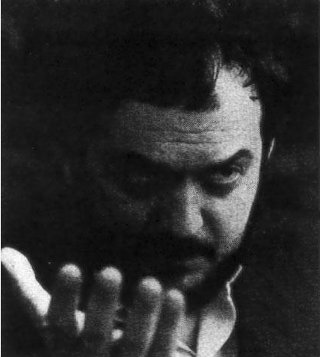
Stanley Kubrick
Again, Kubrick is famous for using this shot, and you can see it in most of his films, often multiple times (see the extended entry for more shots from The Shining and Full Metal Jacket) and being a big Kubrick fan, I was kinda surprised to see it, full formed, in Sunrise.
Of course, neither Murnau or Kubrick have trademarked that stare. In fact, it’s a rather common human expression (indeed, my nieces frequently make that face whenever their crazy uncle Marky does something silly). Filmmakers of the stature of Kubrick or Murnau just managed to capture well enough that it stands out. Kubrick’s consistent use of that image made it iconic enough that he sorta made it his own. Now, whenever someone uses a shot like that, it’s considered an homage to Kubrick… but watching Sunrise is interesting in that light (seeing as though that film was made a solid 30 years before Kubrick even started making movies). More screenshots below the fold…
Jack Nicholson flashes the expression numerous times throughout The Shining:
The Shining
Vincent D’Onofrio seems to be using the Kubrick Stare by way of the Thousand Yard Stare (or vice versa?) in Full Metal Jacket:
Full Metal Jacket
There are lots of other examples I could use, but I’ll leave it at that for now…
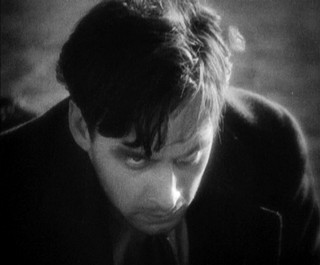
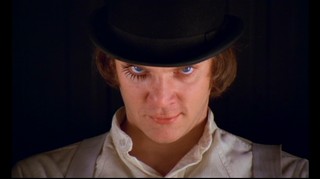
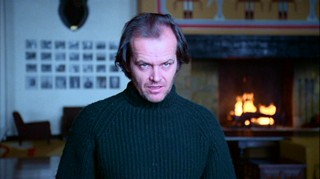
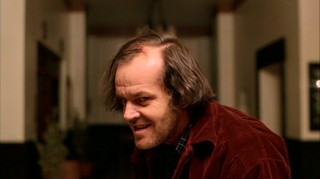
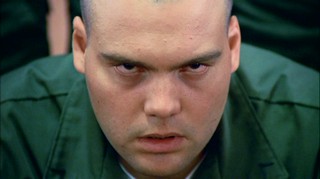
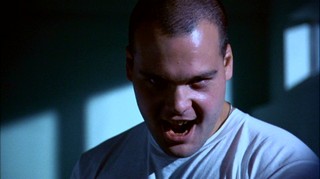
My husband is a big Kubrick fan, so it should really be no surprise that he uses that stare on me a lot, just because he knows it get a reaction out of me. It’s evil.
I wonder how long humans have used this facial expression and exactly how it expresses ill intentions/impure or naughty thoughts. Maybe something about partly hiding the eyes?
Yeah, that’s an interesting conjecture about the eyes. And I’ve wondered about whether or not its an innate thing. Unfortunately, I don’t have rigorous records of the expressions my nieces throw my way, so I can’t check there (though I do wonder where they picked it up – I guess it could be common enough that I don’t take note when other people do it, but whatever).
It reminds me of how Japanese emoticons are all about eyes (while US emoticons are all about the mouth). So 🙂 is analogous to ^_^. I’ve probably mentioned this 10 times on the blog, but I do find that interesting (it comes up a lot in anime – what I call closed eye syndrome).
The other thing about this expression is that you could see it as subverting a different expression, which is bowing. I’m just speculating here, but when you bow, I’m pretty sure you’re also expected to lower your eyes as well. This puts you into a somewhat vulnerable position (even if you can see enough in your peripheral vision, it’s vulnerable symbolically). So when you bow to someone in greeting, it’s like a sign of good faith and trust. And in some cultures, it’s customary to bow in apology or thanks, which would also fit.
So the Kubrick stare kinda subverts that because it’s bowing the head without taking the eyes off of the recipient. So it sorta symbolizes the opposite of a traditional bow (even if it isn’t always used in the same situations as the traditional bow).
Or maybe I’m just talking out of my ass. Probably worth further consideration…